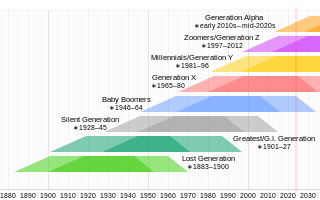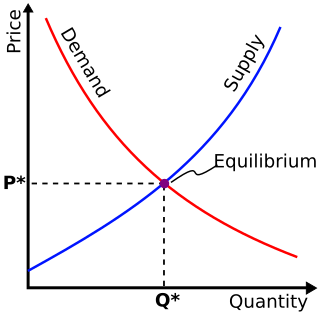Related Research Articles

Baby boomers, often shortened to boomers, are the demographic cohort preceded by the Silent Generation and followed by Generation X. The generation is often defined as people born from 1946 to 1964 during the mid-20th century baby boom. The dates, the demographic context, and the cultural identifiers may vary by country. Most baby boomers are the children of either the Greatest Generation or the Silent Generation, and are often the parents of the younger members of Generation X and Millennials. In the West, boomers' childhoods in the 1950s and 1960s had significant reforms in education, both as part of the ideological confrontation that was the Cold War, and as a continuation of the interwar period. Theirs was a time of economic prosperity and rapid technological progress. In the 1960s and 1970s, as this relatively large number of young people entered their teens and young adulthood—the oldest turned 18 in 1964, the youngest in 1982—they, and those around them, created a very specific rhetoric around their cohort, and the social movements brought about by their size in numbers, such as the counterculture of the 1960s and its backlash.

A generation is all of the people born and living at about the same time, regarded collectively. It also is "the average period, generally considered to be about 20–30 years, during which children are born and grow up, become adults, and begin to have children." In kinship, generation is a structural term, designating the parent–child relationship. In biology, generation also means biogenesis, reproduction, and procreation.

Millennials, also known as Generation Y or Gen Y, are the demographic cohort following Generation X and preceding Generation Z. Researchers and popular media use the early 1980s as starting birth years and the mid-1990s to early 2000s as ending birth years, with the generation typically being defined as people born from 1981 to 1996. Most Millennials are the children of Baby Boomers and older Generation X. In turn Millennials are often the parents of Generation Alpha.

The United States is a country primarily located in North America. Demographics of the United States concern matters of population density, ethnicity, education level, health of the populace, economic status, religious affiliations, and other aspects regarding the population.

The poverty threshold, poverty limit, poverty line, or breadline is the minimum level of income deemed adequate in a particular country. The poverty line is usually calculated by estimating the total cost of one year's worth of necessities for the average adult. The cost of housing, such as the rent for an apartment, usually makes up the largest proportion of this estimate, so economists track the real estate market and other housing cost indicators as a major influence on the poverty line. Individual factors are often used to account for various circumstances, such as whether one is a parent, elderly, a child, married, etc. The poverty threshold may be adjusted annually. In practice, like the definition of poverty, the official or common understanding of the poverty line is significantly higher in developed countries than in developing countries.
Fertility in colloquial terms refers the ability to have offspring. In demographic contexts, fertility refers to the actual production of offspring, rather than the physical capability to reproduce, which is termed fecundity. The fertility rate is the average number of children born during an individual's lifetime. In medicine, fertility refers to the ability to have children, and infertility refers to difficulty in reproducing naturally. In general, infertility or subfertility in humans is defined as not being able to conceive a child after one year of unprotected sex. The antithesis of fertility is infertility, while the antithesis of fecundity is sterility.

Social mobility is the movement of individuals, families, households or other categories of people within or between social strata in a society. It is a change in social status relative to one's current social location within a given society. This movement occurs between layers or tiers in an open system of social stratification. Open stratification systems are those in which at least some value is given to achieved status characteristics in a society. The movement can be in a downward or upward direction. Markers for social mobility such as education and class, are used to predict, discuss and learn more about an individual or a group's mobility in society.

Birth rate, also known as natality, is the total number of live human births per 1,000 population for a given period divided by the length of the period in years. The number of live births is normally taken from a universal registration system for births; population counts from a census, and estimation through specialized demographic techniques such as population pyramids. The birth rate is used to calculate population growth. The estimated average population may be taken as the mid-year population.

The total fertility rate (TFR) of a population is the average number of children that are born to a woman over her lifetime, if they were to experience the exact current age-specific fertility rates (ASFRs) through their lifetime, and they were to live from birth until the end of their reproductive life.

Sub-replacement fertility is a total fertility rate (TFR) that leads to each new generation being less populous than the older, previous one in a given area. The United Nations Population Division defines sub-replacement fertility as any rate below approximately 2.1 children born per woman of childbearing age, but the threshold can be as high as 3.4 in some developing countries because of higher mortality rates. Taken globally, the total fertility rate at replacement was 2.33 children per woman in 2003. This can be "translated" as 2 children per woman to replace the parents, plus a "third of a child" to make up for the higher probability of males born and mortality prior to the end of a person's fertile life. In 2020, the global average fertility rate was around 2.4 children born per woman.

The middle of the 20th century was marked by a significant and persistent increase in fertility rates in many countries, especially in the Western world. The term baby boom is often used to refer to this particular boom, generally considered to have started immediately after World War II, although some demographers place it earlier or during the war. This terminology led to those born during this baby boom being nicknamed the baby boomer generation.

Intergenerational equity in economic, psychological, and sociological contexts, is the idea of fairness or justice between generations. The concept can be applied to fairness in dynamics between children, youth, adults, and seniors. It can also be applied to fairness between generations currently living and future generations.

Family economics applies economic concepts such as production, division of labor, distribution, and decision making to the family. It is used to explain outcomes unique to family—such as marriage, the decision to have children, fertility, time devoted to domestic production, and dowry payments using economic analysis.

The Easterlin paradox is a finding in happiness economics formulated in 1974 by Richard Easterlin, then professor of economics at the University of Pennsylvania, and the first economist to study happiness data. The paradox states that at a point in time happiness varies directly with income both among and within nations, but over time happiness does not trend upward as income continues to grow: while people on higher incomes are typically happier than their lower-income counterparts at a given point in time, higher incomes don't produce greater happiness over time. One explanation is that my happiness depends on a comparison between my income and my perceptions of the average standard of living. If everyone's income increases, my increased income gives a short boost to my happiness, since I do not realize that the average standard of living has gone up. Some time later, I realize that the average standard of living has also gone up, so the happiness boost produced by my increased income disappears. It is the contradiction between the point-of-time and time series findings that is the root of the paradox: while there is a correlation at a fixed point, there is no trend over multiple points. That is, in the short run, everyone perceives increases in income to be correlated with happiness and tries to increase their incomes. However, in the long run, this proves to be an illusion, since everyone's efforts to raise standards of living lead to increasing averages, leaving everyone in the same place in terms of relative income. Various theories have been advanced to explain the paradox, but the paradox itself is solely an empirical generalization. The existence of the paradox has been strongly disputed by other researchers.
Richard Ainley Easterlin was an American economist. A professor of economics at the University of Southern California, he is best known for the economic theory named after him, the Easterlin paradox. Another of his contributions is the Easterlin hypothesis about long waves of baby booms and busts.
The relationship between fertility and intelligence has been investigated in many demographic studies. There is evidence that, on a population level, measures of intelligence such as educational attainment and literacy are negatively correlated with fertility rate in some contexts.

Demographic economics or population economics is the application of economic analysis to demography, the study of human populations, including size, growth, density, distribution, and vital statistics.
A two-child policy is a government-imposed limit of two children allowed per family or the payment of government subsidies only to the first two children.

In demographic terms, aging refers to an increase in the proportion of senior citizens to the total population. The term "senior citizen" encompasses those aged 65 or older. In 2045, South Korea is projected to become the world's most aged population, surpassing Japan. Senior citizens will reach 46.5 percent of the population in 2067, outnumbering the working age population.

In recent decades, the fertility rate of the United States has declined below replacement level, prompting projections of an aging population and workforce, as is already happening elsewhere in the developed world and some developing countries. The decline has been most noticeable since after the Great Recession of the late 2000s. Nevertheless, the rate of aging in the United States remains slower than that seen in many other countries, including some developing ones, giving the nation a significant competitive advantage. Unintentional pregnancies have become less common; in particular, teenage pregnancies have dropped to record lows.
References
- ↑ Richard A. Easterlin. 1961. “The American Baby Boom in Historical Perspective.” American Economic Review 51 (5): pp. 869–911.
- ↑ Richard A. Easterlin. 1975. Studies in Family Planning, 6 (3): pp. 54-63.
- ↑ Matthias Doepke, Moshe Hazan, and Yishay D. Maoz, 2015. "The Baby Boom and World War II: A Macroeconomic Analysis," Review of Economic Studies, vol. 82(3), pp. 1031-1073.
- ↑ Matthew J. Hill, Easterlin revisited: Relative income and the baby boom, Explorations in Economic History, Volume 56, April 2015, Pages 71-85.
- ↑ Pampel, Fred C.; Peters, H. Elizabeth (1995). "The Easterlin Effect". Annual Review of Sociology. 21: 163–194. ISSN 0360-0572.
- ↑ Diane J. Macunovich. 1998. "Fertility and the Easterlin hypothesis: An assessment of the literature," Journal of Population Economics vol 11, pp.1–59.
- ↑ Easterlin RA. 1979. What will 1984 be like? Socioeconomic implications of recent twists in age structure Demography, 15: 397-432. PMID 738471 DOI: 10.2307/2061197